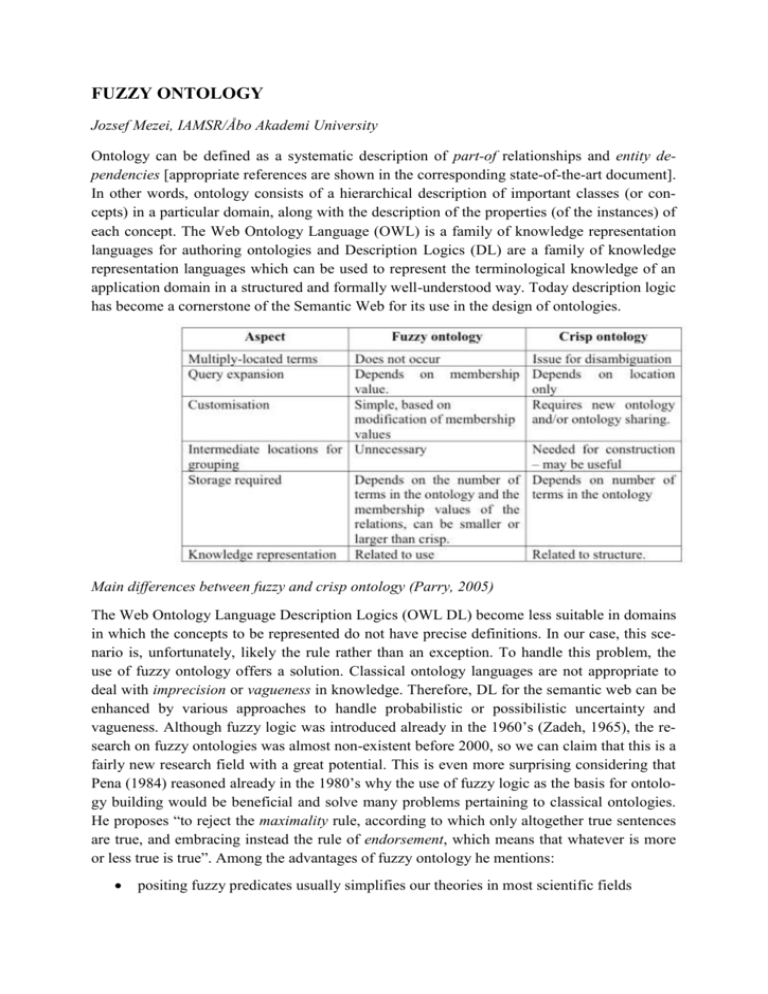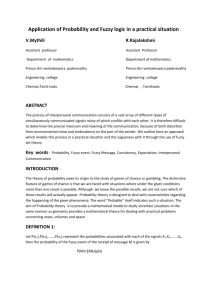fuzzy ontology - Data to Intelligence
advertisement

FUZZY ONTOLOGY Jozsef Mezei, IAMSR/Åbo Akademi University Ontology can be defined as a systematic description of part-of relationships and entity dependencies [appropriate references are shown in the corresponding state-of-the-art document]. In other words, ontology consists of a hierarchical description of important classes (or concepts) in a particular domain, along with the description of the properties (of the instances) of each concept. The Web Ontology Language (OWL) is a family of knowledge representation languages for authoring ontologies and Description Logics (DL) are a family of knowledge representation languages which can be used to represent the terminological knowledge of an application domain in a structured and formally well-understood way. Today description logic has become a cornerstone of the Semantic Web for its use in the design of ontologies. Main differences between fuzzy and crisp ontology (Parry, 2005) The Web Ontology Language Description Logics (OWL DL) become less suitable in domains in which the concepts to be represented do not have precise definitions. In our case, this scenario is, unfortunately, likely the rule rather than an exception. To handle this problem, the use of fuzzy ontology offers a solution. Classical ontology languages are not appropriate to deal with imprecision or vagueness in knowledge. Therefore, DL for the semantic web can be enhanced by various approaches to handle probabilistic or possibilistic uncertainty and vagueness. Although fuzzy logic was introduced already in the 1960’s (Zadeh, 1965), the research on fuzzy ontologies was almost non-existent before 2000, so we can claim that this is a fairly new research field with a great potential. This is even more surprising considering that Pena (1984) reasoned already in the 1980’s why the use of fuzzy logic as the basis for ontology building would be beneficial and solve many problems pertaining to classical ontologies. He proposes “to reject the maximality rule, according to which only altogether true sentences are true, and embracing instead the rule of endorsement, which means that whatever is more or less true is true”. Among the advantages of fuzzy ontology he mentions: positing fuzzy predicates usually simplifies our theories in most scientific fields fuzzy predicates are much more plausible, and give us a much more attractive and cohesive worldview, than their crisp counterpart degree-talk and comparative constructions In recent years, it has been pointed out that classical ontologies are not appropriate to deal with imprecise and vague knowledge, which is inherent to several real world domains (Sanchez, 2006). Surveying the literature, we can find that there is no unique definition of fuzzy ontology. In the simplest case (Dey and Abulaish, 2008), a fuzzy ontology is a pair (C, R), where C is a set of (fuzzy) concepts and R is a set of (fuzzy) binary (n-ary) relations. In different approaches, this pair can be extended in numerous ways: individuals (I), fuzzy axioms (A), (Calegari and Ciucci, 2007) concept hierarchy (H) and axioms (Sanchez and Yamanoi, 2006) attributes of a concept, concept hierarchy, fuzzy events of a concept (Zhou et al., 2006) The process of constructing a fuzzy ontology as extended domain ontology Fuzzy ontology can be seen as an extended domain ontology (Inyaem et al., 2010), which makes use of the specific domain and fuzzy information processing as follows: (i) the input is unstructured data; (ii) the definition of related concepts in the domain, e.g. instances, objects, and their relationships; (iii) the generation of domain ontology; (iv) the domain ontology extended as fuzzy ontology; and (v) applying the fuzzy ontology to the specific domain. It is important to note, that most of the definitions in the literature are quite restrictive and are mostly anchored to a specific application area. In his doctoral thesis, Bobillo (2008) formulated a general definition: “a fuzzy ontology is simply an ontology which uses fuzzy logic to provide a natural representation of imprecise and vague knowledge and eases reasoning over it.” Re the description logic behind the reasoning, the most popular is fuzzy SHOIN(D), a fuzzy generalization of SHOIN(D) which is one of the classical logic schemes used in the Semantic Web. This approach allows concrete domains (data types) to be represented by fuzzy sets. Moreover, it introduces fuzzy modifiers, fuzzy axioms, fuzzy RBoxes, fuzzy TBoxes, and fuzzy ABoxes. The fuzzy SHOIN(D) was originally proposed for logic-based information retrieval in a document management system (Straccia, 2006). In fact, SHOIN(D) is an equivalent of OWL DL, and from this follows that fuzzy SHOIN(D) is convenient as a formal basis for bringing vagueness into OWL. There are numerous proposals to encode vague information into OWL, such as using OWL extension, transforming fuzzy DL into classical DL, and last but not least using OWL2 annotations. Bobillo and Straccia (2011) developed a procedure to represent imprecise information in current standard languages and tools by identifying the syntactic differences that a fuzzy ontology language has to cope with, and by proposing a specific methodology to represent fuzzy ontologies using OWL 2 annotation properties. FuzzyOWL2 allows a developer to encode (i) linear and triangular fuzzy modifiers, (ii) left-shoulder, right-shoulder, triangular and trapezoidal fuzzy data types, (iii) fuzzy concepts, (iv) fuzzy roles and (v) fuzzy axioms. Recently, some papers combine fuzzy ontologies with fuzzy Formal Concept Analysis to elicit conceptualizations from datasets and generate a hierarchy-based representation of extracted knowledge (De Maio et al., 2012, Chen et al., 2011, Formica, 2012) A recent development in the field is the appearance of type-2 fuzzy ontologies (T2FO). Lee et al. (2010) introduced a T2FO, which is composed of (i) a type-2 fuzzy personal profile ontology; (ii) a type-2 fuzzy food ontology; and (iii) a type-2 fuzzy-personal food ontology. Li et al. (2007) introduce a type-2 fuzzy version of ALL and describe its syntax, semantics and reasoning algorithms, as well as the implementation of the logic with type-2 fuzzy OWL. Lee et al. (2010) developed a Fuzzy Markup Language (FML)-based type-2 fuzzy ontology to represent the computer Go knowledge, including an FML transformation mechanism, a type-2 fuzzy set construction, and a type-2 fuzzy set inference mechanism. Bukhari and Kim (2012) employ an integrated secure type-2 fuzzy ontology multi-agent platform to completely automate the process of manual air ticket booking. Fuzzy ontology generation for the Semantic Web





